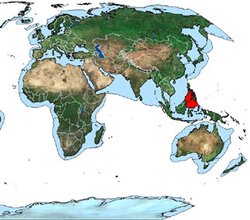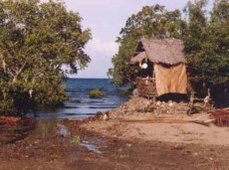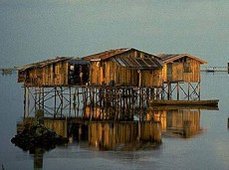Sulu-Celebes Sea large marine ecosystem
 Location of the Sulu-Celebes Sea Large Marine Ecosystem (Source: NOAA)
Location of the Sulu-Celebes Sea Large Marine Ecosystem (Source: NOAA) The Sulu-Celebes Sea Large Marine Ecosystem (LME) is characterized by its tropical climate. It is a semi-enclosed sea bounded by Sabah in northern Borneo (Malaysia), the southwest coast of the Philippines, and Sulawesi Island (northern coast of Indonesia). It has an area of about 900,000 square kilometres, and is comprised of the Sulu Sea and the Celebes Sea (sometimes referred to as the Sulawesi Sea). The LME contains many islands, surrounded by narrow shelf areas. Much of the LME has a depth greater than 3,000 meters (m). The LME is oceanographically well defined and is limited by the Palawan trough to the North and by the Sulawesi Island to the South. There is a deeper area, and a chain of islands known as the Sulu Archipelago, separating the two seas. The Global Environment Facility (GEF) has funded the development of a Transboundary Diagnostic Analysis and the preliminary framework for a Strategic Action Programme for this LME (see GEF/UNDP). An article pertaining to this LME is Food and Agriculture Organization (FAO) of the United States (FAO), 2002.
Contents
Productivity
Surface currents in the Sulu Sea come from the south in the summer. Winter currents follow a counterclockwise gyre. In the Celebes Sea, strong currents, deep sea trench topography, seamounts and active volcanic islands result in a complex oceanography. The tropical climate, warm clear waters of the Celebes Sea, active underwater volcanoes, seamounts, trenches, corals and inter-island passages, currents and upwellings, help make this an exceptionally rich area with great marine biodiversity. There are 1,800 species of fish, 400 species of algae, 5 species of sea turtles, 22 species of marine mammals and over 450 types of coral. There are orcas, whales, sharks, dolphins, manta rays and pelagic species such as tuna and marlin. In the Sulu Sea, Apo Reef and Tubbataha Reef have been shown to be at the center of a system of currents distributing fish and lobster larvae throughout the area. The Sulu-Celebes Seas LME is considered a Class III, low productivity ( <150 grams of carbon per square meter per year) ecosystem based on SeaWiFS global primary productivity estimates. For detailed information on the coral reefs of this LME, see data collected by the University of British Columbia Fisheries Center.
Fish and Fisheries
 LME: Sulu-Celebes Seas (Source: NOAA)
LME: Sulu-Celebes Seas (Source: NOAA) Species fished include whale sharks, manta rays, billfish, prawns, yellowfin tuna, grouper and clams. There are detailed fish statistics with good species breakdown for this LME. The FAO (Food and Agriculture Organization (FAO)) 10-year trend shows an increase in the total catch, from 750,000 tons in 1990, to 850,000 tons in 1999 (see FAO, 2003). There is a high catch percentage for [[coast]al] fishes (23%), pelagic fishes (32%), herrings, sardines and anchovies (23%), and crustaceans (7%). Fish is a primary food resource for the region. Most of the fishing occurs in coastal areas, while the offshore waters are largely unexploited. Coastal trawling is aimed at prawn, a major export. Most of the landings in Indonesia and in the Philippines are from small-scale artisanal fisheries (Fisheries and aquaculture), using a variety of artisanal fishing methods to catch mostly finfish. Traditional fishing techniques include spider web fishing. Several fishing techniques are highly destructive: there is dynamite and cynanide fishing on the reefs of the Philippines, with fishermen coming from nearby Taiwan and Hong Kong. The number of illegal fishermen exploiting the resources of the Reef is steadily increasing. Few countries in the region have implemented fisheries management plans. The University Of British Columbia Fisheries Center has detailed fish catch statistics for this LME. A graph of the data is in the graph "LME: Sulu-Celebes Seas".
Pollution and Ecosystem Health
 (Source: NOAA)
(Source: NOAA) Years of overfishing using dynamite and cyanide have taken their toll on the coral reefs of the Philippines. The country’s marine resources are overstretched, as evidenced by the recent decline in tuna exports. The export and domestic markets continue to take no account of the ecological limits of the ecosystem. Damage to coral communities is caused by careless divers and by boat anchors. Illegal tours by collectors see the marine environment picked of turtle eggs, giant clams and seashells. The Tubbataha Reefs are not free from intrusion and destruction. Both Tubbataha Reef and Turtle Island have fallen prey to the destructive practices of people selling turtle eggs, thereby endangering the continuing existence of these turtles. Local extinction, according to the World Wildlife Fund, is imminent. In 1995, the Philippines Department of Environment and Natural Resources (DENR) revealed that coral cover and fish density in the reef are "decreasing at an alarming rate" despite the site's official status as a protected National Marine Park.
Socioeconomics
 (Source: NOAA)
(Source: NOAA) The indigenous population of this area has harvested the sea's seemingly unlimited supply of marine life for thousands of years. Fish and other marine organisms are a primary food resource. Coastal trawling for prawn supplies a major marine export industry. The LME is presently under threat. The Tubbataha Reef and other coastal areas of the Sulu-Celebes Sea, while serving as important spawning grounds for marine life, also provide a livelihood for the fishing communities crowding its shores. Short-term gain in the guise of uncontrolled exploitation is affecting these habitats. At the same time, these communities need to fish in order to survive. Population pressure, poverty, and a present lack of economic alternatives all contribute to the problem. The resources of the LME are a source of hard currency for the governments. Other economic activities are tourism, and oil and gas production from offshore. Tourism increases every year and contributes to the local and to the national economy.
Governance
The three countries bordering the LME are Malaysia, Philippines and Indonesia. There is a pressing need for improved management and cooperation between countries in conserving and protecting the Sulu-Celebes Sea Large Marine Ecosystem. Enforcement, education and research are necessary measures, as are efforts to curb illegal fishing. In 1988, Tubbataha Reef was declared as the first National Marine Park in the Philippines. In 1993, the United Nations Educational Scientific and Cultural Organization (UNESCO) declared the Reef a World Heritage Site. Turtle Island has also been declared a protected area. These declarations indicate the government's commitment to conserve the areas, and have increased international awareness and support for their protection. When the government ran out of funds to carry out an action plan, international agencies such as the World Wildlife Fund (WWF) and the Global Environmental Facility (GEF) initiated some projects. It is clear that engaging the public is necessary, as well as developing livelihood alternatives for those communities that are affected. WWF’s plan is to raise the communities' awareness level of the existing laws on fisheries and environmental protection. Other international groups that have committed to projects in the area are ASEAN and Conservation International. In 1996 an agreement was signed by Malaysia and the Philippines to protect two endangered (IUCN Red List Criteria for Endangered) turtle species, the Hawksbill and the Green Turtle. Although the Malaysian-Philippines agreement is a vital first step, all three governments in the region need to enforce sustainable ways of earning a living from the sea. Several species of whales are endangered. The GEF/UNDP has funded has funded the development of a Transboundary Diagnostic Analysis and the preliminary framework for a Strategic Action Programme for this LME.
References
Articles and LME Volumes United Nations FAO, 2003. Trends in oceanic captures and clustering of large marine ecosystems—2 studies based on the FAO capture database. FAO fisheries technical paper 435 (Sulu-Celebes Sea large marine ecosystem) . 71 pages.
Other References:
- United Nations. 1972. Atlas of the living resources of the sea. Department of Fisheries, Food and Agriculture Organization of the United Nations (FAO), Rome. ISBN: 9250010001.
- United States NOAA. 1991. Report of the ad hoc Committee on Large Marine Ecosystems. NOAA Technical Memorandum NMFS-F/NEC-92, 19p.
- Thia-Eng, Chua and J.A. Mathias (Editors). 1978. Coastal resources of West Sabah: An investigation into the impact of oil spill. Penerbit Universiti Sains Malaysia, Pulau Pinang, Malaysia. 296 pp.
See Also
| Disclaimer: This article contains certain information that was originally published by the National Oceanic and Atmospheric Administration (NOAA). Topic editors and authors for the Encyclopedia of Earth have edited its content and added new information. The use of information from the National Oceanic and Atmospheric Administration (NOAA) should not be construed as support for or endorsement by that organization for any new information added by EoE personnel, or for any editing of the original content. |